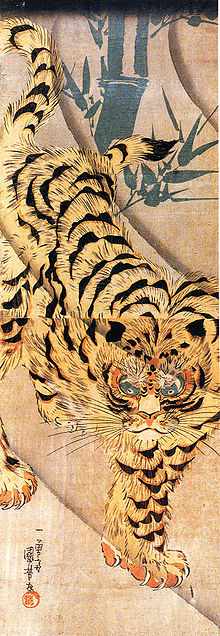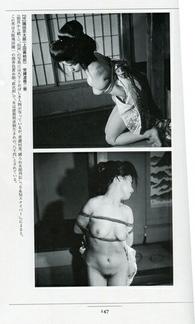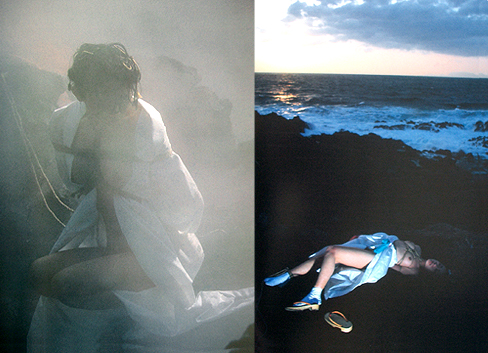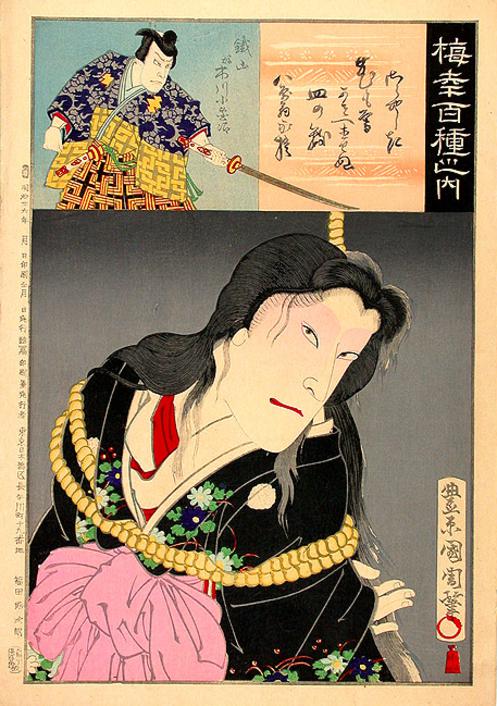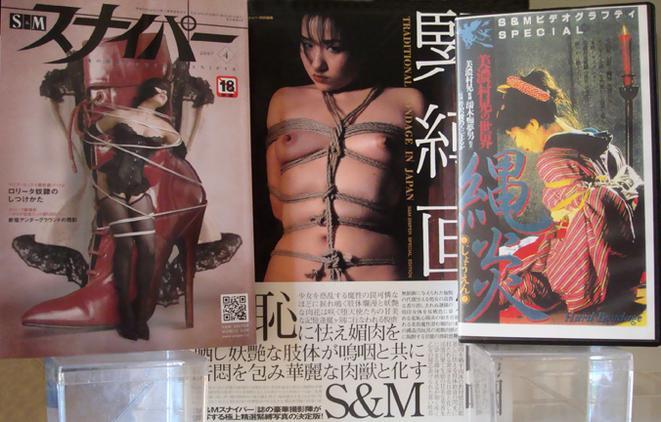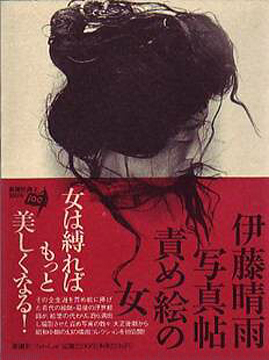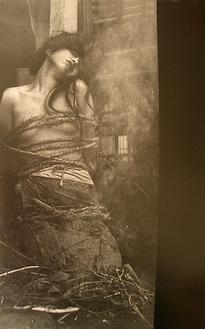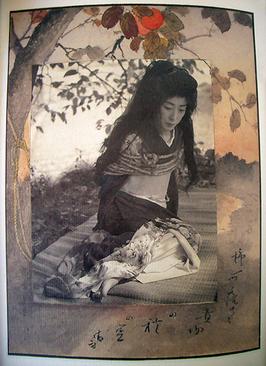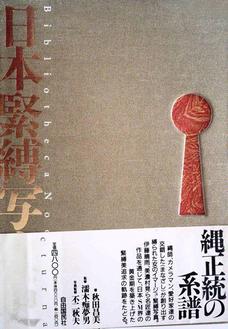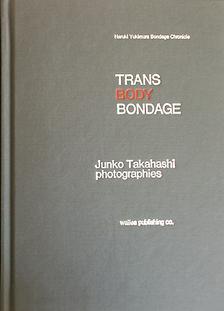Chapter One
The 10 Greatest Kinbaku Photography Books Ever Published
(imho) - Part 1
by Master "K"
One of the great pleasures of writing "The Beauty of Kinbaku" was the opportunity to investigate and present so many of the interesting artworks, books and pictures that have been associated with the practice of Kinbaku (erotic rope bondage) over the years. There really has been and still is a remarkable amount of art with a capital "A" out there on exhibit and for the collector. Whether it's prints advertising kabuki plays from the 17th and 18th centuries or the more modern "rope books" that were so ubiquitous in Tokyo for so many years or the illustrations that went into so many SM magazines during the "Golden age" of SM publishing in Japan (in the late 1950s and early 1970s), the amount of collectable material is simply remarkable.
I must confess that, almost without realizing it, over the course of 40 years of studying the art of Kinbaku I've built up a rather large collection of books, films and fine art on the subject which I used as illustrations for my book. Because of this I'm often asked by students and friends the question, "What are the best Kinbaku art, movies, illustrations or photo books?" It's a natural question, but it's a tough one to answer. There simply is a LOT of different types of art out there.
The Beauty of Kinbaku
Or everything you always wanted to know about Japanese erotic bondage when you suddenly realized that you didn't speak Japanese
Kinbaku
and Art
Kabuki Actor Print by Kunichika Toyohara (1835-1900)
Modern Kinbaku Media
Stray Doll Cover
Anna Fabuki in Stray Doll
A Composite of Two Images From Strange Fruit
Demon Mask Image From Strange Fruit
Page from History of Japanese Bondage Photography
Itoh's Photography work - Cover
Itoh's Photography Work
Itoh Collage
Transbody Bondage - Cover
Yukimura Bondage
Please note: no part of these articles may be reproduced by any means without the express written consent of the author or the publisher, King Cat Ink.
Links to Other Chapters of Kinbaku and Art
However, most of the time people in the West seem to be interested in what are the most interesting, historically important, or just plain beautiful Kinbaku photography books published. This is natural because of the visual impact of these works, the fact that you don't need to understand Japanese to appreciate them and the fact that these photo books have been coming out for decades from Japan and in some ways are the most recognizable and attractive artifacts of the art of Kinbaku as it has evolved over a long period of time.
In this (and the next) post for this site I thought I'd try to answer that question but, of course, opinions on such a subject will vary so I've decided to base my list of the best Japanese Kinbaku photo books ever published on three strict criteria:
- To make the list a book must be by a Japanese artist (or artists) and be of some historical importance. That is, it must be a significant publication in the history of Kinbaku art.
- The book must be beautiful to look at. That is, it must be well made and have Kinbaku of good, professional quality and fine photography.
- Whenever possible the book ought still be able to be purchased. After all, a list of impossible to find esoteric photo books on Kinbaku wouldn't be of interest to anyone but the specialist collector. Not only that, to make such a list would be highly pretentious and elitist.
These criteria have meant that any works by Westerners have been omitted (including my good friend Osada Steve's wonderful book "Aiko" which he did with one of his favorite models.) They also caused some other slight anomalies.
For instance, the well-known Kinbaku photographer Sugiura Norio does not have any works included on my list. The reason for this is that, while he has published many Kinbaku books over the years and despite the fact that his work is very striking, none of it has been so historically significant, in my opinion, as to make the list.
And so to begin. Over the next two posts I'm going to countdown what I believe to be the 10 most significant Kinbaku books from the dawn of the SM publishing age when these materials were first offered to the public right on through to the peak of quality publication in the mid-1990s and then on to the present day.
10.) Katsumi Oka, Fuji Akio and Ryosuke Aikawa. Stray Doll. Tokyo: Cinemagic, 1995.
One of the most beautiful books from the
peak period of quality Kinbaku book
publishing in the mid-1990s is "Stray Doll"
(1995), featuring the lovely model Anna
Fubuki and Kinbakuby the legendary
Chimuo Nureki.
What makes this book so special is the "four season" approach to the photography, which was by Oka Katsumi, Akio Fuji and Aikawa Ryos. The gorgeous model Anna Fabuki is portrayed against beautiful backgrounds of pink, green, gold and white in spring, summer, fall and winter which lends an elegant Japanese feel to the entire book. The exterior nude photography is exceptional as is Nureki's tying making this publication one of the very best of the "coffee-table" size books that raised the artistic level of Kinbaku book publication in the 1990s.
9.) Ishigaki Akira. Strange Fruit (a limited edition deluxe photo album). Tokyo: Doyou Shuppan Shinsha, 1982 (Reprinted in an edited version by Shinkosha, 1993).
Ishigaki Akira was still in his 20's and
a rising photographic star when his
publishers commissioned his second
photo book and asked him to include
some images of Kinbaku carefully
executed by the little known bakushi
Roppongi Kaoru. Shot quickly in 1982
at various locations outside of Tokyo
(beaches, woods, an old inn), the album
is a remarkable piece of work.
Haunting, evocative, colorful and
beautifully lit, its images take Kinbaku
photography, up until then almost
exclusively the province of SM and
"adult" magazines, to a different level
of artistry, one that would pave the
way for other large format kinbaku art
books (featuring the work of Nureki
Chimuo and Akechi Denki, among
others) that would appear in the 1990's.
Strange Fruit Cover
"Strange Fruit" was released in a limited, "deluxe" edition in 1982 to only modest success in Japan. However, it did get Ishigaki (and by extension the kinbaku of Roppongi) an exhibition in 1983 at the East Bridge Gallery in New York City which then resulted in a small selection of Ishigaki's kinbaku images being printed in the March, 1984 issue of the prestigious French photography magazine "Photo," thus making the works of photographer Ishigaki and bakushi Roppongi Kaoru some of the first true Japanese kinbaku images ever presented in a Western general audience magazine.
8.) Akita, Masami (with Fuji, Akio and Nureki, Chimuo). Nihon Kinbaku Shashin-shi (The History of Japanese Bondage Photography). Tokyo: Bibliotheca Nocturna, 1996.
While this remarkable book is not
strictly a photography book its
significance to Kinbaku photo book
publication is far too great for it not
to being included in this list. The
talented musician Masami Akita
collaborated with legendary bakushi
Nureki Chimuo to produce a history
of postwar Kinbaku magazine and art
photography in 1996. Though some of
the scholarship has since been
questioned, for the Western reader,
the attraction of this book is its over
300 small black-and-white images taken
from the extensive files of Uramado
magazine (second in importance only to
Kitan Club in the "golden age" of
Japanese SM publishing) that chart
the course and development of Kinbaku
art photography from the postwar
years of Itoh Seiyu (the "father" of
modern Kinbaku) through the remarkable
publishing career of Minomura Kou (a
true genius as bakushi, writer, publisher
and editor) and on to the present day.
This unique panorama of classic images
makes this book a must have for the collector.
History of Japanese Bondage Photography - Cover
7.) Kawaguchi, Hiroshi. Itoh Seiyu Shashin-cho/Seme-e no Onno (Itoh Seiyu’s photographic work). Tokyo: Photo Musee, 1996.
This museum quality paperback published in
1996 is the finest collection of Itoh Seiyu's
remarkable photographic work from the early
postwar years. As the "father" of modern
Kinbaku Itoh's influence on the art form was
immense (he first began publishing his art
and photos in the early 20th century) and
when this is added to his status as a truly
controversial artistic figure in Japan any book
of his photographic work must be included on
any Kinbaku photo book "best of" list. The
numerous black-and-white photos in this book
reveal Itoh as both an artist and researcher as
they record his explorations and study of the
martial art of hojojutsu, the forerunner of
modern Kinbaku, as well as various Edo era
"punishment" techniques. There is also a nice
selection of his photographic collage work.
6.) Yukimura, Haruki. Trans Body Bondage (photos by Takahashi Junko). Tokyo: Wailea Publishing, 1998.
Yukimura Haruki’s, “Trans Body Bondage”
(1998) is a wonderful book that pays homage
to Yukimura's great skill as a bakushi (rope
master) and almost takes the practice of
erotic tying into the realms of modern art.
This is thanks to the female photographer
Takahashi Junko's penchant for close-up
photography which sometimes turns
Yukimura's rope into abstract patterns.
This title is sometimes available separately
but also can be found in a re-packaged
format that includes a video of Yukimura
at work.
It's also a beautifully made volume and,
interestingly, it's in the small format used
for the ukiyo-e books (nishiki-e) that were
printed as souvenirs for travelers (usually
on foot) to Edo (modern day Tokyo) in
earlier centuries when a "pocket book"
meant just that. As they say, "good
things come in small packages."
As I mentioned, while sometimes not easy to find, all of these fascinating works still come up for sale from time to time on the web or in used book shops in Japan. For instance, earlier this year 5 copies of one of the top 5 books on this list appeared for sale on E-Bay in the US!
Please join me next time as I continue to countdown
the 10 best Kinbaku photo books of all time!
